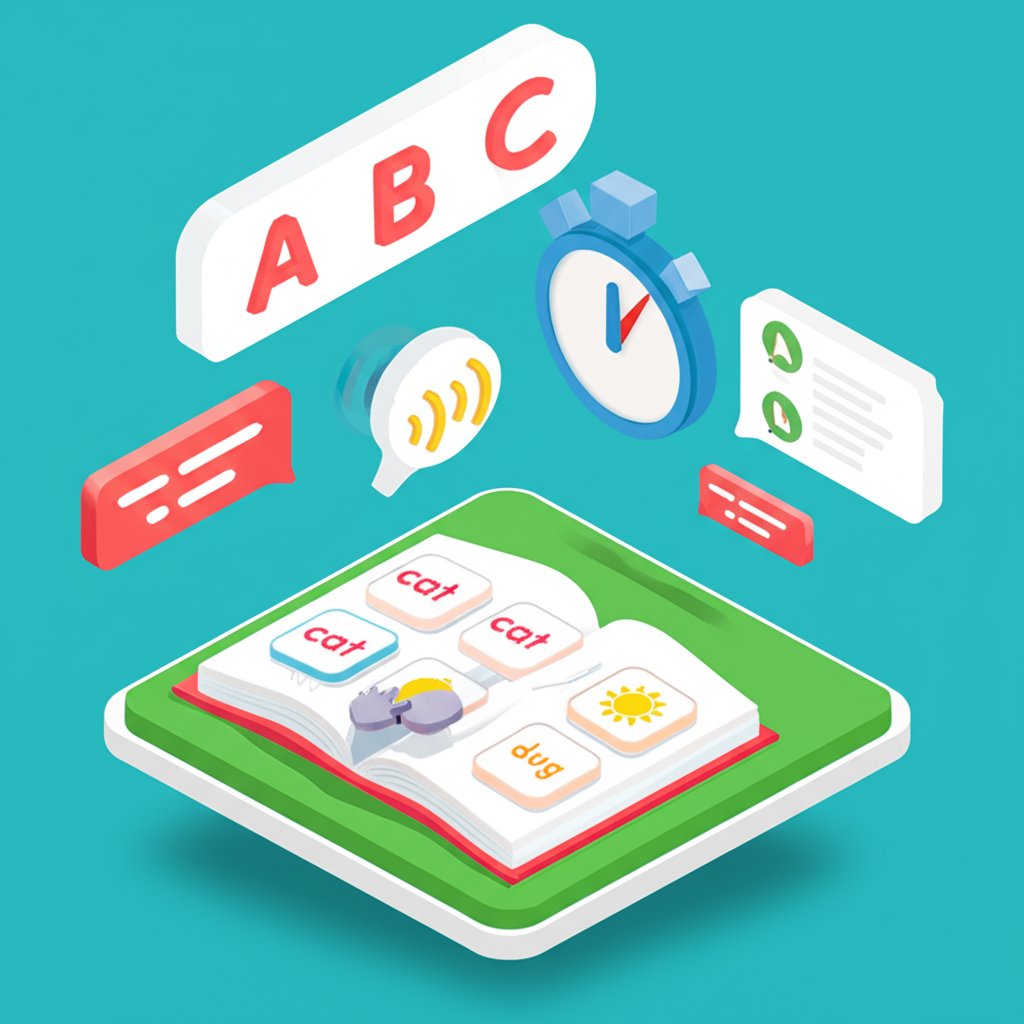Imagine a classroom where every student confidently decodes words, eager to unlock the stories within books. This isn’t a pipe dream, but a tangible goal achievable through targeted, data-driven instruction. The cornerstone of this approach? The quick phonics screener. This essential tool provides teachers with swift, actionable insights into a student’s foundational reading skills, allowing for precise interventions that empower learners and accelerate reading development.
This comprehensive guide will dive deep into everything you need to know about quick phonics screeners. We’ll explore their purpose, the key skills they assess, how to choose the perfect one for your classroom, and most importantly, how to transform the data you collect into powerful, personalized instruction. Get ready to revolutionize your phonics teaching and boost every student’s reading potential!
Understanding the Power of a Quick Phonics Screener
At its core, a quick phonics screener is a targeted assessment designed to provide a rapid snapshot of a student’s phonics knowledge and decoding abilities. Unlike lengthy diagnostic tests, these screeners are efficient, typically taking just minutes per student, making them ideal for busy educators seeking immediate insights.
Why Every Teacher Needs a Quick Phonics Assessment
Phonics is the bedrock of reading. Without a solid understanding of how letters and sounds connect, students struggle to decode words, leading to frustration and disengagement. A quick phonics assessment becomes indispensable for several reasons:
- Early Identification: It pinpoints specific phonics gaps early, before they become ingrained reading difficulties. Research consistently shows that early intervention is far more effective.
- Personalized Learning: It moves beyond a one-size-fits-all approach, providing data to tailor instruction to individual student needs, promoting equitable learning outcomes.
- Data-Driven Instruction: It empowers teachers to make informed decisions about curriculum, small group formations, and intervention strategies, ensuring every minute of instruction is impactful.
- Science of Reading Alignment: It directly supports the principles of the Science of Reading, emphasizing systematic and explicit phonics instruction. Knowing what skills students lack allows for direct teaching of those skills.
- Progress Monitoring: When administered periodically, a quick phonics screener can effectively track student growth over time, demonstrating the effectiveness of your teaching strategies.
By utilizing a quick phonics assessment, you’re not just identifying weaknesses; you’re building a precise roadmap for fostering reading success.
Key Components: What Does a Quick Phonics Assessment Cover?
A truly effective quick phonics assessment or quick phonics survey delves into a spectrum of foundational skills crucial for decoding and encoding. While specific screeners may vary, most cover the following critical areas:
1. Letter Names and Sounds (Alphabetic Principle)
- Assessment: Students identify individual uppercase and lowercase letters and state the sound(s) each letter represents.
- Importance: This is the absolute first step in decoding. Without knowing letter-sound correspondence, a child cannot blend sounds to read words.
2. CVC Words (Consonant-Vowel-Consonant) & Short Vowels
- Assessment: Students read simple three-letter words with short vowel sounds (e.g., cat, dog, bed, pin, sun).
- Importance: Mastering CVC words builds confidence and solidifies the understanding of basic phonetic patterns. Struggling here often indicates difficulty with short vowel discrimination or blending.
3. Consonant Blends and Digraphs
- Assessment: Students read words containing consonant blends (two or three consonants blended together, like bl in blue, st in stop, str in street) and digraphs (two letters making one sound, like sh in ship, ch in chair, th in this, wh in when).
- Importance: These patterns add complexity. Difficulty here suggests students may be segmenting individual sounds rather than recognizing the blended or digraph sound unit.
4. Long Vowel Patterns (CVCe, Vowel Teams)
- Assessment: Students read words with silent ‘e’ patterns (CVCe, e.g., bake, bike, hope) and common vowel teams (two vowels making one sound, e.g., boat, rain, play, meet).
- Importance: These represent more advanced vowel patterns. Understanding them is key to reading a wider range of words and moving beyond basic phonetic spelling.
5. R-Controlled Vowels
- Assessment: Students read words where a vowel is followed by ‘r’, changing the vowel’s sound (e.g., car, bird, fur, fork, her).
- Importance: R-controlled vowels are notoriously tricky. Assessing this helps identify students who need explicit instruction on these distinct vowel sounds.
6. Diphthongs
- Assessment: Students read words with diphthongs, which are vowel sounds where the tongue moves from one vowel position to another within the same syllable (e.g., coin, cloud, joy, house).
- Importance: Diphthongs add another layer of complexity to vowel sounds, often posing challenges for developing readers.
7. Nonsense Words (Pseudowords)
- Assessment: Students read made-up words that follow phonetic rules (e.g., zep, fim, plag).
- Importance: This is a crucial component for truly assessing a student’s decoding skills. Since nonsense words aren’t in a student’s sight word vocabulary, correctly reading them confirms their ability to apply phonics rules, not just memorize words. Many effective qps phonics screener tools incorporate this.
8. Encoding (Spelling Component)
- Assessment: Some comprehensive screeners, often called a Quick Spelling Screener (QSS), include a spelling component where students write words dictated by the teacher.
- Importance: Encoding is the reverse of decoding. A student’s spelling patterns often reveal their phonics understanding (or lack thereof). Struggling to spell a phonetically regular word indicates a gap in their sound-symbol mapping.
By covering these varied aspects, a thorough quick phonics assessment provides a holistic view of a student’s foundational reading abilities, guiding you to areas needing the most support.
Choosing the Right Tool: Navigating Your QPS Phonics Screener Options
Selecting the ideal QPS phonics screener for your classroom is crucial for gathering meaningful data. It’s not about finding the “best” screener universally, but the one that best suits your specific students, curriculum, and teaching context.
Factors to Consider When Selecting a Quick Phonics Survey
Student Age and Grade Level:
- A screener for kindergarteners will focus on basic letter sounds and CVC words.
- A screener for second or third graders (or even older struggling readers) will include more complex skills like vowel teams, r-controlled vowels, and multi-syllabic words.
- Some, like the CORE Phonics Survey, are adaptable for K-12, addressing the needs of students who may have missed foundational phonics instruction regardless of age.
Targeted Skills Alignment:
- Does the quick phonics survey align with your current phonics curriculum or the specific skills you intend to teach next?
- If your students are struggling with blends, choose a screener that deeply assesses blends. If they’re moving into long vowels, ensure the screener covers CVCe and vowel teams comprehensively.
Time Constraints:
- How much time can you realistically dedicate to administering and scoring? Many QPS quick phonics screener options boast administration times of 10-15 minutes per student.
- Consider the setup time and scoring complexity.
Format and Accessibility:
- Paper-and-Pencil: Traditional and easy to implement, but requires printing and manual scoring.
- Digital: Many screeners now offer digital versions where teachers can record responses directly on a device, often with automated scoring (e.g., some TPT resources). This can streamline data collection and analysis.
- Mixed Format: A combination might work best for some classrooms.
Cost and Resources:
- Commercial Screeners: Often come with robust research, multiple versions for progress monitoring, and comprehensive scoring guides. Examples include the Read Naturally Quick Phonics Screener.
- Free Printable Resources: Readily available online (educational blogs, free teacher resource sites). Quality can vary, so review thoroughly. Examples like those from Mrs. Learning Bee (as mentioned in original content) offer detailed profiles.
- District/School Developed: Often tailored to local curriculum, but may not be accessible outside the district.
Diagnostic Depth:
- Does the screener, such as a qps phonics screener, provide enough detail to inform instruction? Beyond a simple score, does it highlight specific types of errors? For instance, does it differentiate between a student who struggles with short ‘a’ versus one who confuses ‘b’ and ‘d’?
Popular Choices for Your QPS Phonics Screener
Understanding the landscape of available tools can help narrow your choice:
| Screener/Type | Cost | Typical Time Required | Target Grade Levels | Key Strengths |
|---|---|---|---|---|
| Read Naturally Quick Phonics Screener | Varies (commercial) | Short (10-15 min) | K-6+ | Comprehensive, includes nonsense words, diagnostic, trusted for over a decade. |
| CORE Phonics Surveys | Varies (commercial) | Short (10-15 min) | K-12 | Adaptable for a wide range of grades, covers alphabet skills to advanced decoding, supports Balanced Literacy approaches. |
| TPT “Phonics Intervention Screener” / QPS | Varies (often paid) | Short (10-15 min) | K-8+ | Often aligns with Science of Reading, easy to administer, clear error analysis, some offer digital versions. |
| Free Online Resources (e.g., educational blogs) | Free | Varies | Primarily K-2 | Highly accessible, good for targeted skill checks, but quality and comprehensiveness can vary. |
| District/School Developed | N/A | Varies | Aligned to district | Highly customized to local curriculum and student population. |
By carefully evaluating these options against your classroom’s unique needs, you can select a quick phonics survey that delivers the most valuable insights for your students.
Administering and Interpreting Your Quick Phonics Survey Results
Administering a quick phonics survey (or qps quick phonics screener) should be a low-stress, positive experience for students. The goal is to accurately assess their skills, not to create anxiety. Equally important is the careful interpretation of the results to translate raw data into actionable instructional plans.
Giving the Screener: A Step-by-Step Guide
Prepare Your Environment:
- Find a quiet, distraction-free space where you can work one-on-one with a student.
- Ensure good lighting and comfortable seating.
- Have all materials ready: student copy of the screener, teacher record sheet, pencil, timer (if needed).
Set a Positive Tone:
- Explain the purpose simply: “We’re going to read some words together to see what sounds you know and how well you can read. This helps me find the best ways to help you become an even stronger reader!”
- Emphasize that it’s not a “test” they can fail, but a way for you to learn about their skills.
- Maintain a calm, supportive, and encouraging demeanor throughout.
Provide Clear Instructions:
- Read the instructions for each section exactly as written in the screener’s manual.
- Model if appropriate (e.g., “I’ll point to a letter, and you tell me the sound it makes”).
- Ensure the student understands what they need to do before starting.
Administer Each Task:
- One-on-one: This format allows for close observation.
- Record Accurately: Mark correct/incorrect responses clearly on your teacher record sheet. Many screeners have specific symbols (e.g., check for correct, dash for incorrect, specific codes for error types like substitution or omission).
- Observe and Annotate: This is critical! Note how a student responds. Do they guess? Do they sound out slowly? Do they self-correct? Do they struggle with specific vowel sounds or blends? These qualitative observations are invaluable.
- Stick to Time Limits (if applicable): Some phonics assessments have time limits per section or for the entire assessment.
- Use Nonsense Words: When presented, explain clearly: “These are made-up words, but they follow the same rules as real words. Just sound them out the best you can!”
Finish Positively: Thank the student for their hard work and effort. Reiterate your positive expectations for their reading growth.
Understanding the Results: Unlocking Insights
Interpreting the data from your quick phonics screener transforms raw scores into a personalized learning recipe.
Review the Scoring Guide:
- Most screeners come with detailed scoring guides or rubrics. Familiarize yourself with these before you begin.
- Calculate formal scores for each section as instructed (e.g., number correct out of total).
Look for Patterns, Not Just Scores:
- Individual Student Patterns: Is the student consistently missing short ‘i’ sounds? Are they struggling with all vowel teams, or just specific ones? Do they omit the beginning blend in words? Are they stronger at decoding than encoding, or vice versa?
- Class-Wide Patterns: After screening your whole class, tally common errors. If half of your class struggles with silent ‘e’ words, that indicates a need for explicit whole-group instruction or small groups focused on that skill.
Analyze Error Types:
- Substitutions: Replacing one sound with another (e.g., “bun” for “bin”).
- Omissions: Leaving out a sound (e.g., “op” for “stop”).
- Additions: Adding an extra sound.
- Reversals: Confusing letters like ‘b’ and ‘d’ or ‘p’ and ‘q’.
- Vowel vs. Consonant Errors: Is the student struggling more with vowel sounds or consonant sounds?
- Blending vs. Segmenting: Can they blend sounds into words but struggle to segment words into individual sounds for spelling?
Consider the “Why”:
- A low score on CVC words might mean a lack of letter-sound knowledge OR difficulty with blending. Your observations during administration will help clarify this.
- Nonsense word performance is a strong indicator of true phonics skill application. If a student reads real words but not nonsense words, they might be relying on memorization or context, not decoding.
By meticulously administering and thoughtfully interpreting the results of your quick phonics survey, you gain invaluable insights that directly inform and enhance your instructional practices.
From Data to Action: Supercharging Instruction with Your QPS Quick Phonics Screener
The true power of a QPS quick phonics screener isn’t in the data itself, but in what you do with it. Transforming assessment insights into targeted, impactful instruction is where student growth truly accelerates.
1. Differentiated Instruction and Small Group Work
The data from your quick phonics screener provides the blueprint for effective differentiation:
- Form Flexible Groups: Group students who exhibit similar phonics needs (e.g., all struggling with short vowels, or all needing work on r-controlled vowels). These groups should be fluid, changing as students master skills and new needs emerge.
- Targeted Mini-Lessons: Within these small groups, deliver explicit, systematic mini-lessons directly addressing the identified gaps.
- Example: If a group struggles with consonant blends (“bl,” “st”), focus lessons on blending two or three consonant sounds, using visual aids, phonics charts, and decodable texts specifically featuring those blends.
- Example: For students confusing long ‘a’ vowel teams (“ai,” “ay”), provide activities to sort words by these patterns, practice reading words with these patterns, and engage in “word building” activities.
- Individualized Support: For students with more significant gaps, utilize one-on-one interventions. This might involve re-teaching specific letter sounds, intensive blending practice, or using specialized phonics programs.
2. Tailoring Whole-Class Instruction
While screeners highlight individual needs, patterns across the class can inform whole-group instruction:
- Review and Reinforce: If a significant portion of your class struggles with a particular skill (e.g., digraphs), plan a review unit or integrate more practice opportunities into your daily lessons.
- Pre-teach: Use the data to anticipate future challenges. If students have a shaky foundation in short vowels, you might spend extra time solidifying those before moving onto more complex long vowel patterns.
3. Integrating with Decodable Texts
- Match Text to Skill: Ensure students are reading decodable texts that primarily feature the phonics patterns they are currently learning or reviewing based on their qps quick phonics screener results. This builds confidence and reinforces newly acquired skills.
- Purposeful Reading: For students working on CVC words, provide books rich in CVC words. For those on vowel teams, provide texts with heavy vowel team usage. This allows them to apply their phonics knowledge in context.
4. Monitoring Progress and Adjusting Instruction
The process doesn’t end after the first quick phonics assessment. Ongoing monitoring is essential:
- Re-Screening: Administer sections of the QPS quick phonics screener or a similar quick phonics assessment periodically (e.g., quarterly, or after a specific intervention period) to track growth. Have students mastered the previously identified skill?
- Anecdotal Notes: Continuously observe students during reading and writing. Are they applying the taught phonics skills? Are new errors emerging?
- Flexibility: Be prepared to adjust your instructional plans based on new data. If a strategy isn’t working, try another. If students master a skill faster than expected, move them forward.
5. Leveraging Encoding for Decoding
Remember the spelling component (QSS)?
- Spelling as a Diagnostic: Analyze spelling errors. A student who spells “boat” as “bot” is likely struggling with vowel teams. This immediately tells you what phonics skill needs reinforcement.
- Spelling as Practice: Integrate word study activities where students sort, build, and write words according to specific phonics patterns, reinforcing the sound-symbol relationships.
By systematically using the insights from your QPS quick phonics screener, you create a dynamic and responsive learning environment where every student receives the precise support they need to become a confident, proficient reader.
Advanced Strategies & Future-Proofing Phonics Instruction

To truly dominate reading instruction, leveraging quick phonics screeners goes beyond basic administration and interpretation. It involves integrating advanced strategies and considering the broader literacy landscape.
1. Technology Integration for Streamlined Data
The digital realm offers powerful tools to enhance your qps phonics screener process:
- Digital Recording Sheets: Many screeners are now available in digital formats (e.g., Google Sheets or specialized apps) that allow teachers to input data directly, often with automated scoring and data visualization. This saves time and reduces manual error.
- Progress Monitoring Platforms: Explore educational technology platforms that can track student phonics growth over time. These platforms often generate reports that clearly show individual and class trends, making it easier to identify students needing intervention or acceleration.
- Interactive Phonics Activities: Utilize apps and online games that target specific phonics skills identified by your quick phonics assessment. Gamified learning can increase engagement and provide repeated practice in an enjoyable format.
2. Fostering Home-School Connection with QPS Data
Parents are crucial partners in a child’s reading journey. Use your quick phonics screener data to facilitate meaningful communication:
- Transparent Reporting: Share results in an clear, jargon-free manner. Instead of just a score, explain what skills were assessed and where their child demonstrates strengths or needs support.
- Actionable Strategies for Home: Provide parents with simple, tangible ways to support phonics at home. This could include practicing letter sounds, reading decodable books together, or playing word games that reinforce specific phonics patterns.
- Collaborative Goal Setting: Work with parents to set realistic goals based on the screener results, creating a united front in supporting the child’s reading development.
3. Connecting Phonics to a Broader Literacy Framework
Remember that phonics is just one piece of the reading puzzle, albeit a critical one. A qps phonics screener should always be viewed within the context of comprehensive literacy:
- Fluency: Once students can decode words, they need to read them smoothly and with expression. Phonics instruction directly feeds into fluency development.
- Vocabulary: As students decode more words, their exposure to new vocabulary expands. Explicit vocabulary instruction should always accompany phonics.
- Comprehension: The ultimate goal of reading is comprehension. Phonics removes the decoding barrier, allowing students to focus their cognitive energy on understanding the text. Ensure that even early decodable texts foster comprehension through discussion and questioning.
- Writing: Phonics skills are reciprocal with writing (encoding). Strong phonics knowledge helps students spell words and apply phonetic principles in their written expression.
4. Continuous Professional Development
The field of reading science is constantly evolving. Staying informed is key:
- Science of Reading: Deepen your understanding of the Science of Reading principles. This foundational knowledge will enhance your ability to select, administer, and interpret your quick phonics assessment more effectively.
- Workshop and Training: Seek out professional development opportunities focused on phonics instruction, diagnostic assessment, and intervention strategies.
- Peer Collaboration: Share insights and strategies with colleagues. Discussing qps quick phonics screener results and instructional approaches can lead to innovative solutions and shared best practices.
By adopting these advanced strategies, teachers can not only effectively utilize quick phonics screeners but also create a robust, responsive, and future-proof literacy program that genuinely boosts reading for all students.
Frequently Asked Questions About Quick Phonics Screeners
What is the difference between a quick phonics screener and a diagnostic assessment?
A quick phonics screener is designed for efficiency and broad identification of potential gaps. It provides a snapshot of skills and helps group students for targeted instruction. A diagnostic assessment, on the other hand, is much more in-depth, often taking longer to administer and providing highly detailed information about why a student is struggling with a particular skill. Screeners identify what the problem might be; diagnostic assessments delve into the root cause.
How often should I administer a qps phonics screener?
Many experts recommend administering a qps phonics screener at the beginning of the school year to establish baseline data. For students identified with gaps, follow-up screeners (or sections of the screener) can be given quarterly or after a specific intervention period to monitor progress. Universal screening is often done 2-3 times a year (fall, winter, spring).
Can I use a quick phonics survey for all grade levels?
While many quick phonics surveys are primarily designed for early elementary grades (K-2), some, like the CORE Phonics Surveys, have versions or components suitable for K-12. This is crucial for identifying foundational phonics gaps in older students who may have missed explicit phonics instruction. Always check the screener’s recommended grade level and skill coverage.
Are there free quick phonics assessment options available?
Yes, absolutely! Many educational websites, blogs, and teacher-sharing platforms (like TeachersPayTeachers, where some free options are available) offer free printable or digital quick phonics assessment tools. While convenient and budget-friendly, it’s essential to vet these resources for quality, comprehensiveness, and alignment with research-based practices (e.g., Science of Reading).
What does QPS stand for in QPS phonics screener?
QPS is simply an acronym for Quick Phonics Screener. It’s a commonly used abbreviation to refer to these efficient, targeted assessments. When you see “QPS,” it’s referring to a quick phonics screener or qps quick phonics screener instrument.
How do nonsense words help in a qps quick phonics screener?
Nonsense words (or pseudowords) are crucial because they directly assess a student’s ability to apply phonics rules rather than relying on memorization or sight word recognition. If a student can correctly decode a made-up word like “blip” or “zog,” it demonstrates they truly understand the sound-symbol relationships and blending skills, proving their phonetic decoding ability. This feature is a strong indicator of a robust qps quick phonics screener.
Unlock Reading Potential with Quick Phonics Screeners

The journey to confident reading begins with a clear understanding of where each student stands. Teachers’ Quick Phonics Screeners: Boost Reading! by providing that essential clarity, enabling you to deliver the precise, impactful instruction your students deserve. By embracing the power of the quick phonics screener, implementing a thoughtful quick phonics assessment, navigating your QPS phonics screener options, and acting on the insights from your quick phonics survey, you are not just teaching phonics – you are igniting a lifelong love of reading.
Take the next step: choose a qps quick phonics screener that aligns with your needs, administer it with care, and transform the data into a powerful engine for student growth. Your students’ reading success starts now.











2 thoughts on “Teachers’ Quick Phonics Screeners: Boost Reading!”
Comments are closed.